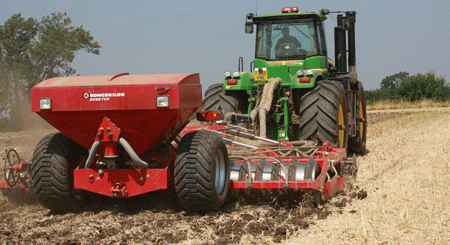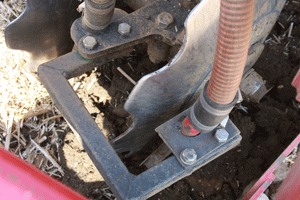NC Quest exhaust-to-soil fertiliser-cutting system comes to the UK

Injecting tractor exhaust gas into the soil to reduce the fertiliser bill probably isn’t an idea that will have occurred to many growers. But Canadian farmer Gary Lewis (pictured), who heads NC Quest in Alberta, says trials on 45 farms in Canada, the USA and Australia prove the principle works.
Keen to spread the word, he has teamed up with Leicestershire contractor Steve Heard to adopt and market this technology in the UK. And, for the first time in Britain, 60ha (150 acres) of wheat are due to be sown using the system this year.
Mr Lewis says injecting exhaust gases into the soil as it is cultivated offers several benefits.
“Exhaust gas places active soluble nitrogen into the soil, but, more importantly, also carbon and nitrogen at a ratio of 30:1, which is perfect for the development of nitrogen-fixing, free-living bacteria.”

While the chemistry is fairly involved, the result, he claims, are plants that create their own nitrate, develop better root systems and have much less reliance on fertiliser. Soil acidity is also reduced due to the action of carbon dioxide in acidic soils.
The benefits list continues with extra trace elements such as phosphorus, potassium, calcium and manganese and a drop in carbon dioxide entering the atmosphere.

But setting up a tractor so its exhaust is injected into the ground is not as easy at it might seem Steve Heard reckons he has spent upwards of £7000 adapting his John Deere 9330.
“We have incorporated a valve-operated T-junction off the exhaust manifold so the exhaust can flow either as normal through the stack or diverted for injection,” he says. “From the manifold the gas flows into a cooler which uses a bank of electric fans, and then on through a hydraulic booster fan to ensure the back pressure on the engine’s turbocharger is maintained at the correct level.”
The 15cm diameter outlet pipes are then routed through to the back of the tractor and out, via connectors, to the cultivator, where manifolds distribute the gas to individual discs or coulters.
On the 4.5m Sumo cultivator being used, the gas exits pipes placed to the side of discs and tines so it is incorporated into the soil almost immediately. Later, when the field is drilled using a Vaderstad 6m pneumatic drill, the gas will be channelled from the tractor through the fan and down to the coulters.
“It’s early days and we hope this year’s trials, where nitrogen fertiliser use will range from zero to full amounts on different field areas, will present us with some real evidence that this system works,” he says.

